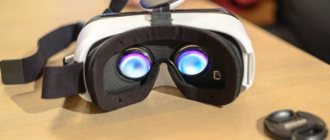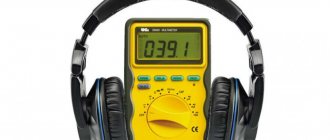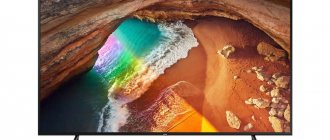The future has arrived: virtual reality has migrated from the frames of futuristic films into our pockets. The release of Google Cardboard glasses made it available for just 5-10 dollars to almost every smartphone owner. More expensive (and reliable) analogues of VR headsets are also produced, made in a high-quality plastic case, equipped with comfortable straps, additional buttons and other “tricks”. An example of such VR glasses is Samsung Gear VR, designed for Korean flagships.
Minimum requirements for smartphones for virtual reality
In the case of Gear VR, the requirements for the device come down to one point: the smartphone for VR must be called Galaxy Note 4, 5, 7 or Galaxy S6, S7 (both regular and Edge). Each model has its own version of virtual reality glasses, differing in the shape and size of the smartphone mount. All these devices are united by the fact that they have a screen with a resolution of 2560x1440 pixels. But VR glasses from Korea do not work with other people’s devices.
Google Cardboard
Google's VR headset and its analogues are not tied to specific devices. Theoretically, it remains possible to use any mobile gadget. However, a smartphone for VR must still meet some requirements:
- Dimensions . Google CardBoard glasses (and analogues) are usually designed for devices with a screen diagonal of 4.5-5.5 inches. Therefore, a more compact device or a large “shovel recorder” cannot be placed in them properly.
- Permission . The smartphone screen resolution for virtual reality must be at least FullHD (1920x1080 pixels) for an IPS matrix or QHD (2560x1440) for AMOLED. A lower resolution will produce an insufficiently detailed picture, which will quickly tire your eyes. The difference in requirements between AMOLED and IPS is due to the fact that Samsung (the main manufacturer of OLED displays) uses PenTile technology. When using it, the matrix contains fewer subpixels, and they have increased sizes. VR will also work on an HD 720p display, but it will be unpleasant to look at.
- Chipset . Budget processors with 4 cores and weak graphics may not be powerful enough for VR. The smartphone must be equipped with a chip with powerful cores and a good GPU. It should have at least 2 Cortex A72 cores (or better) or 4 Cortex A53 cores (or newer) with a frequency of 1.5-3 GHz. The graphics module must be middle class or higher (minimum Mali x3x, Adreno x1x, PoverVR Gx2xx). Suitable ones include Mali T860, Adreno 510, PowerVR G6200. On a weaker smartphone, virtual reality will also work, but acceptable performance cannot be guaranteed.
- Sensors _ In order for a virtual reality helmet to display the image correctly, the smartphone must have an accelerometer and a gyroscope on board. They will adjust and move the 3D image based on the position of the viewer's head.
- Magnetic sensor (Hall sensor) . Most inexpensive virtual reality glasses are equipped with a single button that operates on a magnetic principle. By interacting with the Hall sensor, the smartphone can be controlled when it is inside the VR headset. Depending on the nature of the button press (fast or slow, short or long, single or double), you can configure the actions performed.
Basic VR requirements for smartphones
If we talk, for example, about glasses from the Gear VR brand, the only thing required is that your smartphone be named Galaxy (models Note 4, 5, 7, S6, S7).
Important! For each of these varieties there is its own version of glasses. They will differ only in the size of the fasteners and the shape
Google's VR headset is not tied to any specific devices. The same can be said about its analogues.
Use any smartphone that meets certain requirements:
- operating system: suitable OS Android - from 4.1, Windows - from 7.0, as well as iOS - from 6.0;
- Screen diagonal size: should be from 4.5 to 5.5 inches;
- Screen resolution: FullHD – from 1920x1080 pixels, or QHD – from 2560x1440;
- chipset: a budget processor, even with 4 cores, is not powerful enough;
- sensors: the smartphone must have an accelerometer and a gyroscope or magnetometer, as well as GPS positioning.
Which smartphones are better for VR?
In addition to the fact that any smartphone for VR must meet the recommended requirements, there are other nuances when using virtual reality. First of all, the device should not be a “brick” (like Oukitel K10000, weighing 300 grams). A smartphone that is too heavy will put pressure on the bridge of your nose, reducing the comfort of immersion in virtual reality. The optimal weight is within 100-200 grams (the less, the better).
The load on the device in virtual reality mode increases noticeably; a weak battery will not allow you to watch a long movie. It is advisable to use a smartphone with a capacious battery and good power optimization, such as the Samsung Galaxy J7 2021 or Xiaomi Redmi 3. Since the battery heats up during discharge, and the chipset does not freeze at all, you need to ensure normal heat dissipation. The aluminum body, which is now not so rare, helps to implement it.
Screens without an air gap (Super AMOLED and OGS technologies) are more attractive for VR. This is due to the fact that they provide a higher quality display of virtual reality. The presence of a layer of air between the matrix and the touchscreen can lead to a loss of brightness, a decrease in transparency, and lead to optical distortion.
The image in virtual reality is projected onto the eye from a close distance, so it is better to get a smartphone with good color reproduction. It is typical for AMOLED and TFT IPS matrices. Screens with TFT TN are worse in this regard, although they provide faster image changes (response time 2-5 ms, versus 5-15 ms for IPS).
How do standard smartphone virtual reality glasses work?
The glasses housing consists of a screen partition and two lenses with a visibility range of 110 degrees. This is done to prevent the user from seeing black edges with their peripheral vision, with each lens adding to the stereoscopic graphical distortion that the screen creates in VR mode. To better understand how this works, you can run a small test:
- Focus your eyes on a specific object;
- Close one eye and remember the location of the object;
- Close the other eye while opening the first one. If everything is done correctly, it will be noticeable that the object has moved.
Lens placement
This test proves that human eyes see different images. To achieve a similar result, the smartphone screen will be divided into two identical images with different distortions. Therefore, in order for the picture to be displayed correctly and normally perceived by a person, distortion is used, which is then processed correctly by the brain. But this is only how the device reproduces the picture, but how does the detection of a person in space work?
Mobile phone location
Movement in space is processed through several sensors installed in the smartphone: an accelerometer and a gyroscope, which are designed to calculate the speed and position of the head, and a magnetometer helps to correct the direction of the head displacement. These devices appeared quite a long time ago, but due to the fact that the performance of the technology and the power of these sensors were noticeably weaker, the first models of helmets made their users sick. This reaction is due to the fact that the processor simply did not have time to receive all the data from the sensors and the picture before the person’s eyes was very late. As you know, if the image before your eyes does not change within 50 milliseconds, then the body will begin to malfunction. Fortunately, this happens extremely rarely in new models.
What can you use virtual reality headsets for smartphones for?
Games in VR
The first thought that arises before purchasing a VR BOX is what can it be used for? Many companies are currently promoting their devices, providing them with a variety of content ranging from games to films, small animated stories and 360-degree video views in the YouTube application. Therefore, when buying a VR BOX, you don’t have to worry about buying a “pig in a poke.” Because, among other things, you can dive deeper into the world of games such as Minecraft, GTA and many others.
By what principle does a smartphone connect to glasses?
Wireless mobile phone connection
For many, it is still a mystery how a mobile phone interacts with glasses, but there is nothing complicated about it. Connection takes place in a few simple steps:
- You need to download a special application from Google Play or App Store. Most often, each VR model has its own program, which is indicated on the box or in the instructions; less often, connection occurs with third-party products;
- Depending on the model of the virtual reality headset, the kit may include a control panel for interacting with the helmet being worn. If you have such a remote control, you can put on a helmet with a phone inserted inside and start launching movies, games and everything else;
- If there is no controller, then first launch the VR application and insert the smartphone;
- If the model has image settings and lens focal length adjustment, adjust it to suit you;
- Check functionality by moving your head.
There is nothing complicated in setting up and connecting the device. Next, we will talk about the best glasses models for smartphones.
Possibilities when using VR glasses with a smartphone
When using virtual reality glasses, wide possibilities open up for the user. The list of them is not yet complete, since programmers have not yet implemented all possible VR functions.
- 3D video . _ Specialized players allow you to adapt the picture separately for each eye, and due to the optical effect, the brain perceives the picture as three-dimensional. This way you can watch movies and videos on YouTube. Without virtual reality glasses, the video will look like this:
- 3D games. In games, the same 3D effect creates an immersive experience. The only thing is that to play in 3D, the application itself must support stereoscopy, and for control you need a gamepad connected via Bluetooth, or other controllers, which are made in different forms - from keychains and finger guards to raincoats, there are even rifle-shaped ones.
- Photos and videos in 360 °. Videos and frames shot with panoramic cameras can be viewed in detail by simply turning your head. This allows you to achieve the effect of presence.
- Augmented reality. By receiving an image from a smartphone camera, virtual reality glasses allow you to add virtual elements to it in 3D. This option is limited only by the imagination of software developers. For example, you could theoretically catch Pokemon simply by moving around in VR glasses, or place a virtual home theater in your room.
The guy from YouTube will tell you in detail about the possibilities of VR with a smartphone below.
How virtual reality glasses work
Design Features
Many people consider the terms “VR glasses” and “VR helmet” to be synonymous, but this is not true. So how are virtual reality glasses different from a helmet? It's simple - VR glasses do not have their own display. They consist only of lenses, a case (in the case of glasses, perhaps the wording “frame” would be more appropriate) and a belt. However, the cheapest glasses - cardboard Google CardBoards - do not have a belt and you have to hold them in front of your eyes with your hand. Optionally, a mechanism can be implemented to adjust the distance between the lenses and the distance from the eyes to the lenses. Your smartphone will act as a display.
The brand of virtual reality glasses does not matter much when choosing a model. For example, although Samsung produces very ergonomic VR glasses, they are unreasonably expensive and are only compatible with the flagship Galaxy S and Note smartphones (there is a control chip inside the glasses). Xiaomi has proven itself well as a manufacturer of VR glasses - the Mi VR Play and Mi VR Play 2 models are moderately priced and quite easy to use. There are also a great many “nameless” Chinese VR glasses on sale at a very low price. But their build quality varies greatly, which is especially noticeable on the lenses. Some models have high-quality lenses and view VR content quite comfortably, while others quickly tire your eyes. We recommend looking for reviews about a specific model on the Internet, or better, if possible, personally testing it in a store before purchasing.
The main thing is not to stay in virtual reality for a long time. While scientists have just begun to study the effects of VR on the human psyche, the tiring effect on the eyes and vestibular apparatus has been proven for a long time. The recommended length of a VR session is 15 – 30 minutes, the maximum allowed is 1 hour. VR glasses can also be combined with regular diopter glasses and contact lenses. As long as the frame is not too big and fits inside the VR glasses. Naturally, users with vision problems should be doubly attentive to the appearance of unpleasant sensations in the eyes (dryness, burning, lacrimation).
Diagonal and screen resolution
Most VR glasses support smartphones with screen sizes from 4.5 to 6.4 inches. But which phone is best for virtual reality glasses? But, in our opinion, it’s not worth going to extremes and the optimal diagonal would be from 5 to 5.7 inches. With the same resolution, in the first case, individual pixels will be less noticeable and the picture will appear sharper; in the second case, the viewing angle will be larger and the immersion effect will be stronger.
We recommend a screen resolution of at least 1920×1080 pixels. Of course, 1280x720 is also supported, but individual pixels will look downright huge through diopter lenses. The ideal option is a resolution of 2560x1440 or higher, which allows you to fit two virtual 720p screens in width (required for the stereoscopic effect and, as a result, a three-dimensional image). New-fangled smartphones with an elongated 18:9 aspect ratio are even better suited for VR, since classic 16:9 screens still have an excess of pixels in height (see the article “Display without borders: TOP 5 frameless smartphones.”
Accelerometer, gyroscope and magnetic compass
Why don't virtual reality glasses support this or that phone? A mandatory part of a smartphone for VR glasses is an accelerometer - a simple sensor of movement in space, which, fortunately, is present in all smartphones without exception of the last five years, or even older. If your smartphone can automatically rotate an image from portrait mode to landscape mode, then it has an accelerometer. As a result, you can not only contemplate a static three-dimensional image in virtual reality glasses, but also rotate your head to look around, for example, in a 360-degree circular video.
The second important, but optional element for VR is a gyroscope - a position sensor in space. It is more accurate than the accelerometer and is primarily used in games that require precise aiming with your eyes. Simply put, VR racing can be played on a smartphone with just an accelerometer, while shooters (for example, Zombie Shooter VR and The Lost Future: VR Shooter) require a gyroscope.
The third, least often used element of a smartphone for VR is a magnetic compass (not to be confused with an electronic one). It is only used by VR glasses that have a built-in magnet (for example, Google CardBoard version 2.0). With its help, you can point your gaze at an object in virtual reality (for example, a menu button) and, holding your gaze on it for a few seconds, activate it. If the smartphone does not have a magnetic compass or the glasses do not have a magnet, you can control VR applications and games only by pressing physical buttons on the glasses or an external Bluetooth gamepad.
You can check the presence of all the above-mentioned sensors on your Android smartphone using the AIDA64 application. The latest generation iPhones have all these sensors. If everything is in order, feel free to install the Google Cardboard application (requires Android 4.1+ or iOS 8.0+ OS) and start viewing the VR content collected in it.
Narrowly targeted content
The functionality of VR glasses is very wide and at the same time very limited. There is a lot of content adapted for virtual reality, but it is too monotonous. So what can virtual reality glasses ultimately do? Conventionally, all VR content can be divided into five types:
- racing games: cars, planes, boats, roller coasters;
- shooter games with waves of enemies;
- horror games with screamers (we recommend playing with headphones);
- educational circular videos: nature, museums, concerts;
- 3D videos of erotic and pornographic content.
You can significantly expand the functionality of VR glasses if you have a desktop PC or laptop with a GeForce video card supporting NVIDIA Share technology (models starting from GTX 650 Ti, 750, 950, 1050 or their laptop analogues). Using the Trinus software package, you can configure the broadcast of VR content from a PC to a smartphone via USB or Wi-Fi. This allows you to play, if not in VR mode, then at least in 3D, any computer game: be it GTA V (it supports head rotation), or Skyrim (just a first-person view). In this case, however, there will be a strong image delay, which is why playing, for example, shooters will not be comfortable. But the graphics in computer games are many times better than in mobile games.
We also recommend reading the article:
- “Full immersion: TOP 5 virtual reality glasses”
- “Our whole life is a game: TOP 5 gifts for an avid gamer”
- “5 wearable gadgets from the Samsung Gear line”











